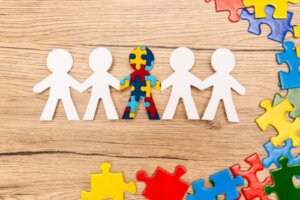Autism Spectrum Disorder: A Range of Complex Realities


Written and verified by the psychologist Elena Sanz
Autism spectrum disorder affects between three and seven percent of school-age children. Moreover, it’s a life-long condition. Fortunately, the understanding of its manifestations and specific needs is growing and society is becoming more aware of the condition. However, some doubts may remain, due to the fact that it’s a heterogeneous condition. In this article, we’re going to explore the different types of autism.
The classification of autism has varied significantly over time. The diagnostic manuals of psychiatry and psychology, which generally guide the understanding and intervention in these cases, include the main advances in the subject. They also propose certain ideas that vary from those of the past. This is just one of the reasons why it’s a good idea to stay updated.
The different types of autism spectrum disorder
Autism is understood today as a spectrum. It’s a set of disorders with common characteristics. These mainly affect communication. Furthermore, sufferers exhibit restricted patterns of interests and behaviors.
Therefore, they tend to experience problems in social interaction, motor skills, and cognition. That said, the manifestations can be extremely diverse and present in varying degrees.
Based on this fact, diagnostic manuals (such as the DSM-IV) traditionally included various types of autism spectrum disorder. As a matter of fact, these used to be called pervasive developmental disorders and a series of symptoms or characteristics of each one were described:
Autistic disorder
Also called Kanner’s syndrome, this is the disorder commonly associated with the term autism. It manifests in early childhood, before the age of three, and significantly affects the aforementioned areas.
Thus, sufferers have little or no use of verbal communication and show minimal interest in social interactions. They exhibit restricted interests and repetitive behaviors, as well as alterations in sensory processing.

Asperger’s disorder
Unlike classic autism, in Asperger’s syndrome there’s no significant language delay, and cognitive development in the early years is appropriate. However, there’s an important alteration in reciprocal social interaction. This means that sufferers experience difficulties in the use of non-verbal behaviors (such as looking into the eyes), the use of empathy, and understanding of irony, double meanings, and indirect language.
In the case of Asperger’s, there’s no intellectual disability, memory is really good, and the sufferer can even do well at school with some help. For this reason, it’s often called high-functioning autism. But, there’s still some motor clumsiness, mental rigidity, and lack of social reciprocity.
Rett syndrome
This syndrome mainly and almost exclusively affects women. It’s characterized by a progressive loss of previously acquired skills. At first, psychomotor development is apparently normal. But, later, a staggered degeneration in motor and speech skills appears.
In fact, between six months and two years, a loss or regression that affects language, movement coordination, manual skills, and social interaction appears.
Childhood disintegrative disorder (CDD)
In this case, normal development followed by sudden regression also occurs. The loss can sometimes occur from the age of two, although it may not become evident until the age of ten.
The affectation occurs in the use of language and communication, social relationships, play, and adaptive behaviors. These are areas in which the child previously showed appropriate progress. However, after a certain point, a loss or regression occurs.
Pervasive developmental disorder – not otherwise specified (PDD-NOS)
This last disorder includes cases in which alterations occur in the same areas, but without fully meeting or fitting the criteria of the previous diagnoses.

The different types of autism today
Experts used this classification in the past as a way of categorizing existing diversity and heterogeneity. But, since 2013 and with the arrival of the DSM-V, its conception has changed. In fact, currently, autism is understood as a spectrum that includes a wide variety of manifestations related to the main areas mentioned earlier.
Today, ASD encompasses traditional autism, Asperger’s syndrome, and PDD-NOS. Rett syndrome is no longer included as it’s been proven to have a clear genetic basis. Neither is CDD because it presents problems of scientific validity.
With this new conception, the aim is to emphasize that autism is more than a category, it’s a dimension. It includes different representations and it can vary depending on the individual and the moment.
Experts only propose two main diagnostic criteria (related to social communication and behavior patterns). That said, they also add various specifiers. These account for important individual details. For example, if there’s an intellectual deficit, language impairment, or any medical condition and the level of severity of the alterations.
Therefore, the different types of autism don’t indicate whether an individual suffers from one or the other syndrome but rather emphasizes the type of deficits they present. Even more importantly, they suggest what type of support sufferers require.
Autism spectrum disorder affects between three and seven percent of school-age children. Moreover, it’s a life-long condition. Fortunately, the understanding of its manifestations and specific needs is growing and society is becoming more aware of the condition. However, some doubts may remain, due to the fact that it’s a heterogeneous condition. In this article, we’re going to explore the different types of autism.
The classification of autism has varied significantly over time. The diagnostic manuals of psychiatry and psychology, which generally guide the understanding and intervention in these cases, include the main advances in the subject. They also propose certain ideas that vary from those of the past. This is just one of the reasons why it’s a good idea to stay updated.
The different types of autism spectrum disorder
Autism is understood today as a spectrum. It’s a set of disorders with common characteristics. These mainly affect communication. Furthermore, sufferers exhibit restricted patterns of interests and behaviors.
Therefore, they tend to experience problems in social interaction, motor skills, and cognition. That said, the manifestations can be extremely diverse and present in varying degrees.
Based on this fact, diagnostic manuals (such as the DSM-IV) traditionally included various types of autism spectrum disorder. As a matter of fact, these used to be called pervasive developmental disorders and a series of symptoms or characteristics of each one were described:
Autistic disorder
Also called Kanner’s syndrome, this is the disorder commonly associated with the term autism. It manifests in early childhood, before the age of three, and significantly affects the aforementioned areas.
Thus, sufferers have little or no use of verbal communication and show minimal interest in social interactions. They exhibit restricted interests and repetitive behaviors, as well as alterations in sensory processing.

Asperger’s disorder
Unlike classic autism, in Asperger’s syndrome there’s no significant language delay, and cognitive development in the early years is appropriate. However, there’s an important alteration in reciprocal social interaction. This means that sufferers experience difficulties in the use of non-verbal behaviors (such as looking into the eyes), the use of empathy, and understanding of irony, double meanings, and indirect language.
In the case of Asperger’s, there’s no intellectual disability, memory is really good, and the sufferer can even do well at school with some help. For this reason, it’s often called high-functioning autism. But, there’s still some motor clumsiness, mental rigidity, and lack of social reciprocity.
Rett syndrome
This syndrome mainly and almost exclusively affects women. It’s characterized by a progressive loss of previously acquired skills. At first, psychomotor development is apparently normal. But, later, a staggered degeneration in motor and speech skills appears.
In fact, between six months and two years, a loss or regression that affects language, movement coordination, manual skills, and social interaction appears.
Childhood disintegrative disorder (CDD)
In this case, normal development followed by sudden regression also occurs. The loss can sometimes occur from the age of two, although it may not become evident until the age of ten.
The affectation occurs in the use of language and communication, social relationships, play, and adaptive behaviors. These are areas in which the child previously showed appropriate progress. However, after a certain point, a loss or regression occurs.
Pervasive developmental disorder – not otherwise specified (PDD-NOS)
This last disorder includes cases in which alterations occur in the same areas, but without fully meeting or fitting the criteria of the previous diagnoses.

The different types of autism today
Experts used this classification in the past as a way of categorizing existing diversity and heterogeneity. But, since 2013 and with the arrival of the DSM-V, its conception has changed. In fact, currently, autism is understood as a spectrum that includes a wide variety of manifestations related to the main areas mentioned earlier.
Today, ASD encompasses traditional autism, Asperger’s syndrome, and PDD-NOS. Rett syndrome is no longer included as it’s been proven to have a clear genetic basis. Neither is CDD because it presents problems of scientific validity.
With this new conception, the aim is to emphasize that autism is more than a category, it’s a dimension. It includes different representations and it can vary depending on the individual and the moment.
Experts only propose two main diagnostic criteria (related to social communication and behavior patterns). That said, they also add various specifiers. These account for important individual details. For example, if there’s an intellectual deficit, language impairment, or any medical condition and the level of severity of the alterations.
Therefore, the different types of autism don’t indicate whether an individual suffers from one or the other syndrome but rather emphasizes the type of deficits they present. Even more importantly, they suggest what type of support sufferers require.
All cited sources were thoroughly reviewed by our team to ensure their quality, reliability, currency, and validity. The bibliography of this article was considered reliable and of academic or scientific accuracy.
- EspectroAutista.Info. (s. f.). F84 Trastornos Generalizados del Desarrollo. http://espectroautista.info/dsmiv.html
- Fundación Adana. (s. f.). Trastornos del Espectro Autista (TEA): Prevalencia. https://www.fundacionadana.org/prevalencia-tea/
- Grosso Funes, M. L. (2021). El autismo en los manuales diagnósticos internacionales: cambios y consecuencias en las últimas ediciones. http://riberdis.cedid.es/handle/11181/6391
- Palomo Seldas, R. (2014). DSM-5: la nueva clasificación de los TEA. Obtenido de https://apacu.info/wp-content/uploads/2014/10/Nueva-clasificaci%C3%B3n-DSMV.pdf
This text is provided for informational purposes only and does not replace consultation with a professional. If in doubt, consult your specialist.







